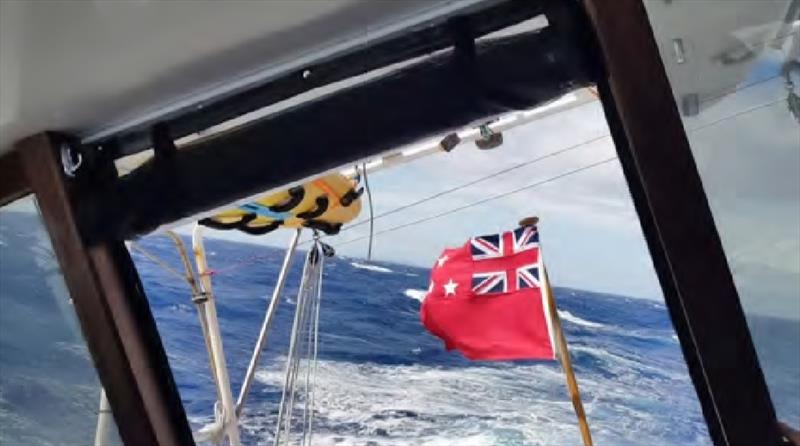
The Passage home
by Nigel Richards 8 Nov 2018 21:39 UTC

The Passage home © Island Cruising NZ
As the end of the tropical cruising season draws near, many boats throughout the South West Pacific are looking at weather options and destination decisions for their next move. Our vessel Varekai being one of the many having made the trip back to New Zealand over the third week of October.
This years' passage plans, weather wise, were dominated in the first part by a very large blocking high pressure system with a centre pressure of around 1038hPa at its peak. This made for a squash zone on its northern edge, up against the South Pacific Convergence Zone. For those that departed during its reign, it produced some exciting and bumpy sailing south of Fiji for four or so days. Of course the up side to that was the lack of passing fronts or lows on the approach to Northern New Zealand.
Many boats made the leap over this period, Customs and MPI at Opua clearing in over ninety boats in one week. We couldn't make the window that week, due to crew arrivals, but left on the next window of the 23rd. The squash zone had reduced a little giving us only 24 hours of bumpy trades outside the Navalu Passage, topping off around 24kts, with a course made good of 204 true. With the excitement of the start of the passage we gave Varekai her reins for a while and she galloped off topping of at 13.2kts, with and average of over nine knots for the first few hours. The brakes went on then for the first night at sea.
The morning saw the trades reducing as expected, we kept our SSW heading in ESE winds of around 12— 15kts, with swells around 2m at 10 second intervals, made for a comfortable day under a clear blue sky. The first two 24 hour runs saw us achieve 185 nm and 180nm. We probably could have cracked the 200 if we had not gone for comfort over speed in the first day. Now the weather was settling into the expected pattern as we tracked toward New Zealand.
When we left Fiji we knew there was a low pressure system developing to the south west of Aotearoa. The big fat highs' influence in that area was reducing, so the more normal for this time of year, high low pattern was starting to emerge. The low had a frontal band that was now due to cross our path around 29s. The wind had started migrating from the E, backing towards the north. We granny gybed in the early evening of the 27th October, setting ourselves up for a starboard tack for the rest of the way.
We also double reefed the main and reduced the headsail in case the front had more of a punch than we expected. Off to the south we could see lightning lighting up the sky in a fantastic mother nature light show. I mentioned this to Peter Mott of Northland Radio during our evening SSB sked. He checked the computer and reported that it was a localised thunderstorm to the south and east of us.
So, with the front passed and the wind continuing its anticlockwise move around the compass, our heading firmed up to a direct rhum line for the Bay of Islands and Nine Pin. The warm sector of the low system produced the expected squally showers, one of which produced the highest wind speed of our passage; a gust of 38kts early on the 28th. During the day the crew took it upon themselves to get into a steering competition with the autopilot. Both Steve and Alice turning in some sound helming in the comfort of the Big V's pilothouse.
The sky brightened up and the squalls were easily seen as they scudded past. The low had deepened past what was predicted at the start of the passage, down to 990hPa and the Met service and our router advised us that we may be heading into a period of high winds. In fact they predicted 30 to 40kts through the afternoon.
We had a crew meeting to discuss our options. One of which was to stop and hove-to until it had passed, or put the third reef in and carry on. The second option was unanimous so off we went. With the high winds on the west coast of North Island, the swell on our side was minimal for the 22 to 24kts we were experiencing. As it turned out those winds were to be our average for the afternoon.
With the flood tight underneath us we tracked towards Nine Pin. As the water shallows up on the land shelf, the seas built a little to create some excellent surf breaks for those so inclined. Land came into view at 1845, the Cavalli Islands to starboard. With land in sight the last push into the Bay, like always, seemed to take forever! But the flash of the Fraser Rock light, off Tapeka point winked its four second welcome.
The tidal push up the Veronica Channel had us alongside the Q dock at 2208, six days and ten hours after leaving Vuda. Customs and MPI visited first thing in the morning. MPI were pleased to see our date stamped video of Varekai's clean bottom. Then the crew received their certificates of two, 1000nm passages aboard Varekai. 'Til next time.....
This article has been provided by the courtesy of Island Cruising NZ.